Paul and Kerry Wilson: Nimbin Valley Dairy's blessed cheese makers
Liina Flynn
11 July 2020, 7:31 PM
 Nimbin Valley Dairy farm owners Kerry Wilson and Paul Wilson.
Nimbin Valley Dairy farm owners Kerry Wilson and Paul Wilson.Blessed are the cheese makers
It’s 7am in the beautiful Nimbin valley and, despite the rain, the blessed cheese makers of Nimbin are already hard at work.
High on a hill at the Nimbin Valley Dairy farm, surrounded by white clouds and mist hanging low over the green hillsides, farm owners Kerry Wilson and Paul Wilson can see fields of lush, green grass and happy-looking goats.
They have been at work since 5am, milking the goats so they can turn the milk into cheese and I’m visiting them to see how cheese is made.
At the milking shed, surrounded by mud, lots of goats are patiently waiting to be milked.
Some are getting bowls filled with feed before they clamber up the ramp onto the milking platform to have milking suction cups attached to their udders.
“Three years ago, we started with three goats to eat the weeds,” Kerry says. “Now we have a herd of 200.”
Kerry tells me he’s the outdoors animal man and farm boy, while Paul, his partner, is the cheese maker.
“When we decided to start making cheese 12 years ago, one of us had to make the cheese,” Kerry explains.
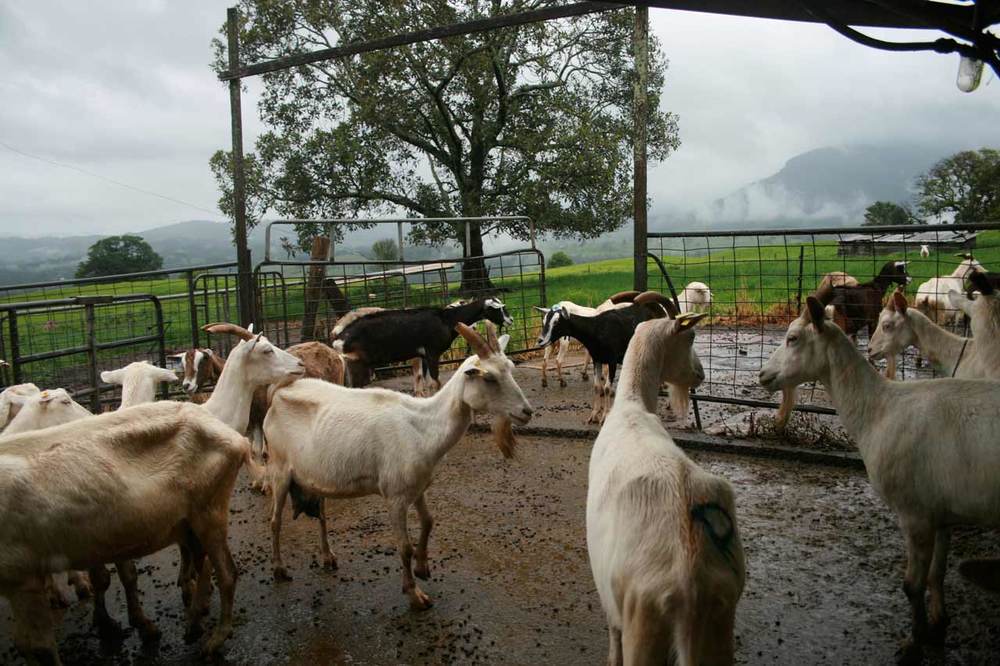
Sociable goats
Kerry tells me their goats are more sociable than cows, as well as being “more emotionally needy”. They also hate the rain and prefer to stay under shelter if they can.
Unlike most cows I’ve met, the goats in the milking pen are up for a scratch between the ears from us and just as I’m taking a picture of them, three goats turn around pose for me in a very human-like manner.
“When you are rounding up cows, you need to get on the quad bike and chase them,” Kerry says.
“But with goats, I only have to stand on the hill and call out ‘goaty, goaty, goaty’, and they all come running.”
Both Kerry and Paul grew up on dairy farms and are used to the early morning farm routine, and by coincidence, they have the same last name.
“We get asked which one of us is the older brother a lot,” Kerry laughs.
As I’m watching the milking process, I can see a large pipe running from the milking machine straight into the cheese-making room next door.
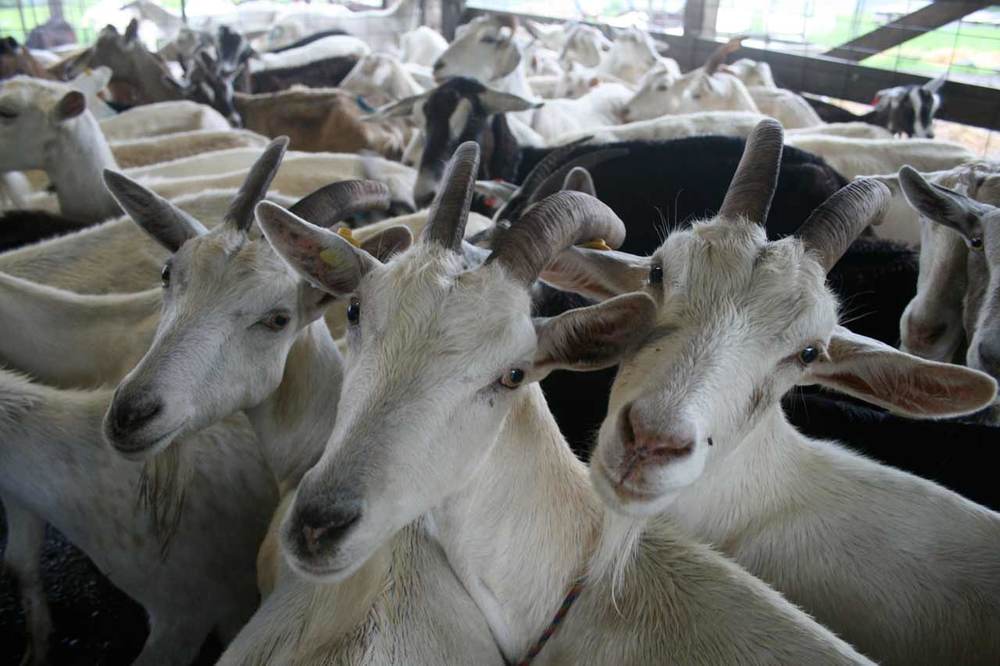
Grass roots
The only thing separating the goats from the cheese is a wall.
This is local cheese making at its grassroots finest.
Unlike many other small dairies, the cheeses are produced here on the farm, direct from the goat to the on-site cheese factory where the cheese is literally made by hand.
Standing in the milking shed, I can see through a little window into one of the cheese-making rooms, where Paul is wearing a little cap to keep any stray hairs out of the cheese.
For Kerry and Paul, the path from raising goats to producing cheese came after they decided they wanted to “do something different” and produce cheese from their goat herd, as well as from the cows at the Wilson family’s dairy farm at Woodlawn.
As the family cheese maker, Paul studied at the National Centre for Dairy Education and in 2007, won the Dairy Australia Cheesemaking Scholarship.
Making cheese has now become Paul’s passion and he regularly attends workshops to learn more about the art of cheese making and cheese ‘culture’ (pardon the pun).
His hard work paid off in 2010, when he won the gold medal at the Brisbane Cheese Awards for his Orange Billy cheese.

The art of cheese
Cheese making is an ancient art that has long allowed humans to preserve milk. Some sources say the earliest archaeological evidence of cheese making has been found in 4000-year- old Egyptian tombs, and it is known that by Roman times, cheese making was a mature art.
It is also thought that Middle Eastern cultures discovered cheese after carting milk around in the stomach of a goat, where the curdling agent rennet is naturally found.
I’m keen to see how the cheese is made, so I make my way to the sanitising room of the cheese factory where Paul is hard at work.
I take off my dirty shoes, slip on a pair of rubber slippers and am transformed into a Cinderella of cheese.
Over my hair goes a white cap and with thoroughly scrubbed and disinfected hands, Paul takes me into the cheese-making room.
I can hear the milk sloshing down the pipe coming from the milking shed outside as it falls into a large, sealed cooling vat.
“I’m making a soft, fresh goat’s cheese today, a bit like a camembert or brie cheese,” Paul says as he stirs 100 litres of warm milk in a large, open vat.
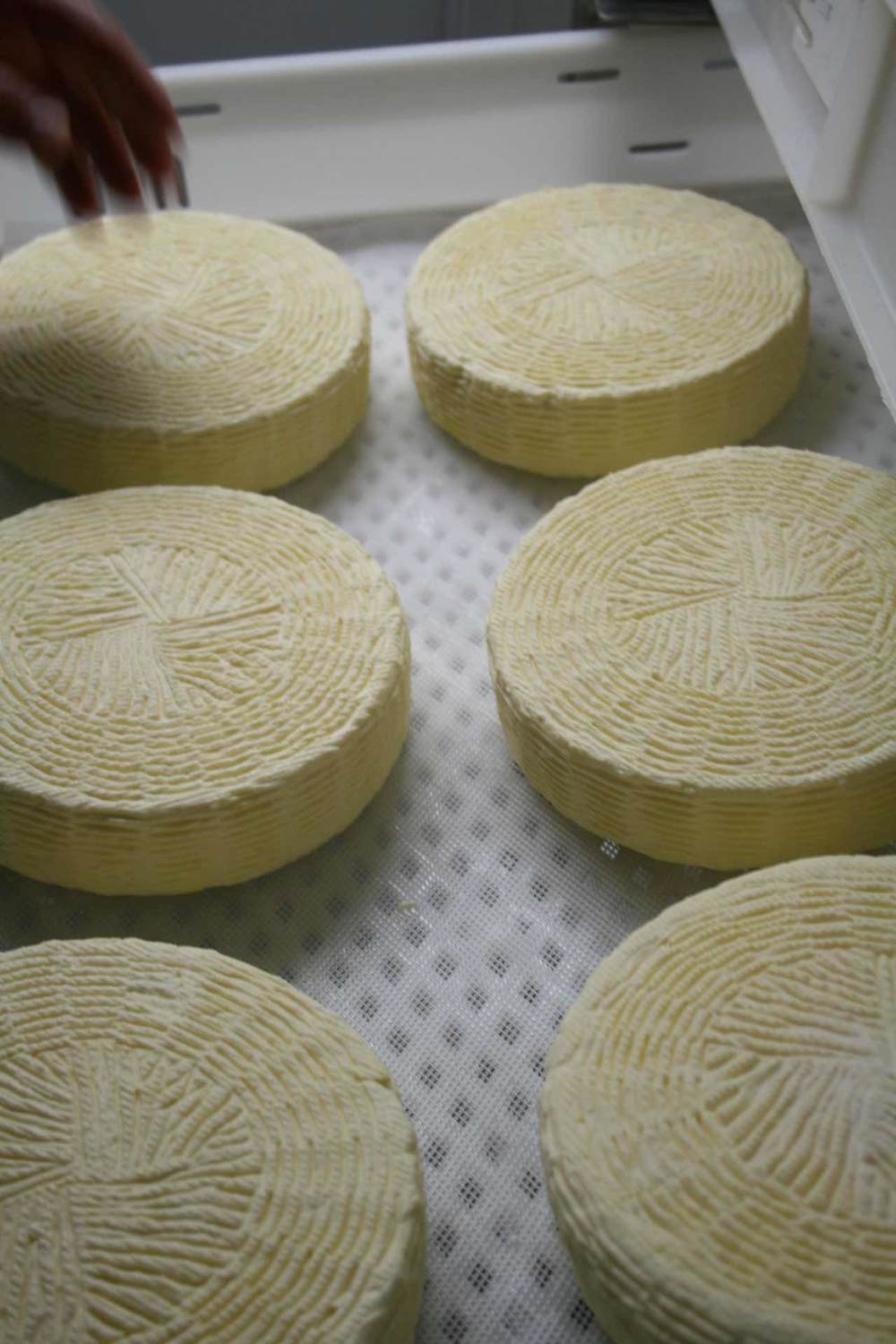
Pasteurisation
Paul explains that before he can make a batch of cheese, the milk has to be pasteurised (heated up) in order to kill any harmful bacteria that might be in the milk.
Every morning, a timer comes on while he’s still in bed and heats the milk for three hours to pasteurise it.
“Pasteurising kills good and bad bacteria,” Paul says. “But we put the good bacteria back in through the different cultures we add to the cheese.”
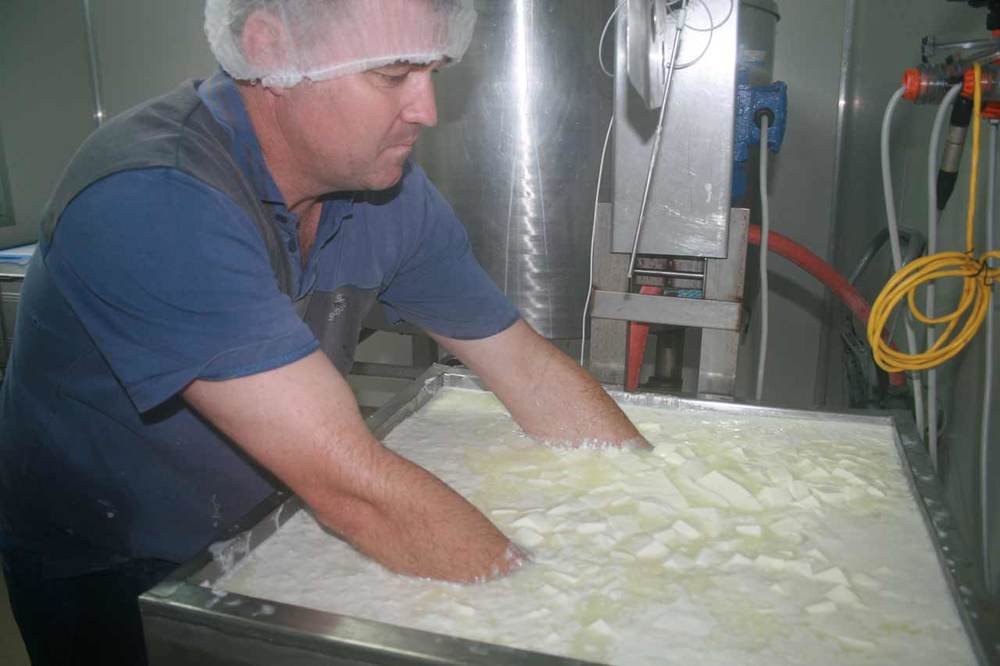
Curds and whey
Paul uses both his hands to stir the milk every 20 minutes and he explains that the rennet enzyme and culture he added a while ago will cause the milk to acidify and separate into curds and whey.
He uses his hand to cut through the top layer of the milk and I can see a yellowing liquid (whey proteins) floating on the top as it begins to separate from the thick white clumps of curd.
The coagulating curds are the fatty milk proteins that Paul will use to make cheese from, but he tells me that the whey won’t go to waste, and will be fed to the goats on the farm.
As the curds thicken, Paul regularly uses different cutting tools to cut the curds into thousands of small floating cubes.
Paul explains that the smaller he cuts the cubes, the more whey will drain out of them when they are put into their moulds.
“Drier, aged cheeses like cheddar need to be cut into tiny cubes so we can get most of the moisture out of them,” Paul explains.
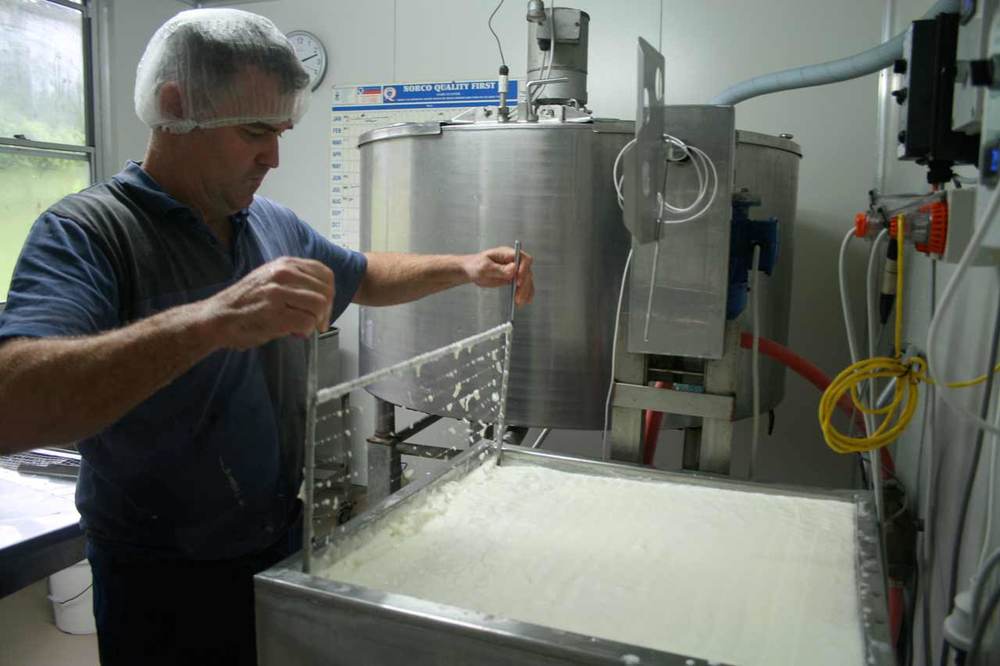
Moisture content
“But because I’m making a soft, fresh cheese today with a higher moisture content, the cubes are a bit larger.”
I now realise that when little Miss Muffett sat on her tuffet eating curds and whey, she obviously was too hungry or impatient to let the curds mature and dry into a vintage cheddar.
It’s more likely she was eating a fresh cheese like ricotta.
While we are waiting for the curds to get thick enough, Paul takes me through to a refrigerated room where he keeps his maturing cheeses. Shelves full of different cheeses covered with colourful moulds line the walls.
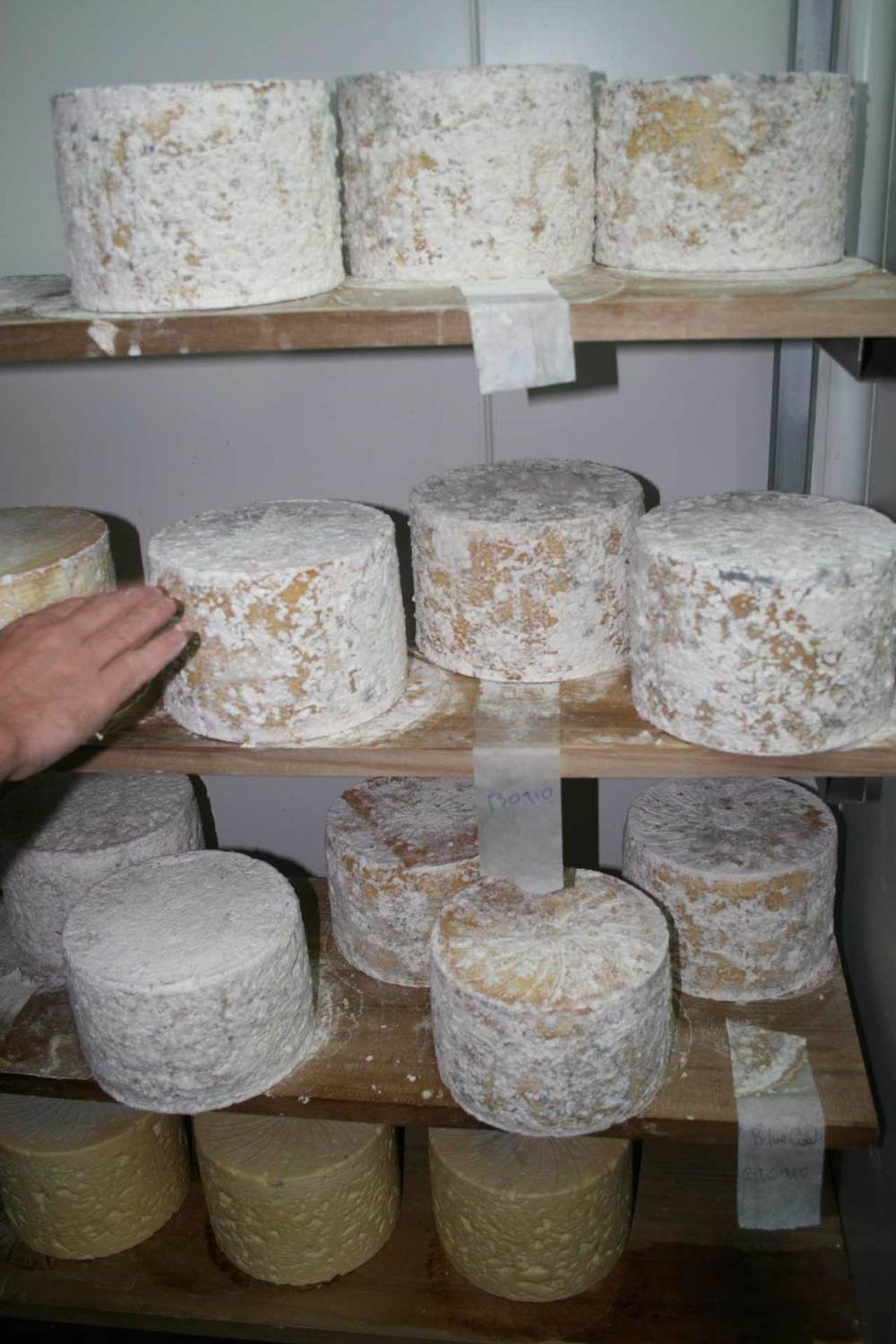
Cheese paradise
It’s a cheese lover’s paradise in here, and certainly not like the dodgy cheese shop from the famous Monty Python skit where no cheese can be found.
Paul pulls out some sliding trays full of goats cheeses in different shapes and sizes, and he turns them over, one by one.
On each cheese, I can see a white fluffy mould growing on the outside.
“I add different cultures to each type of cheese I make to produce a particular type of mould,” Paul says.
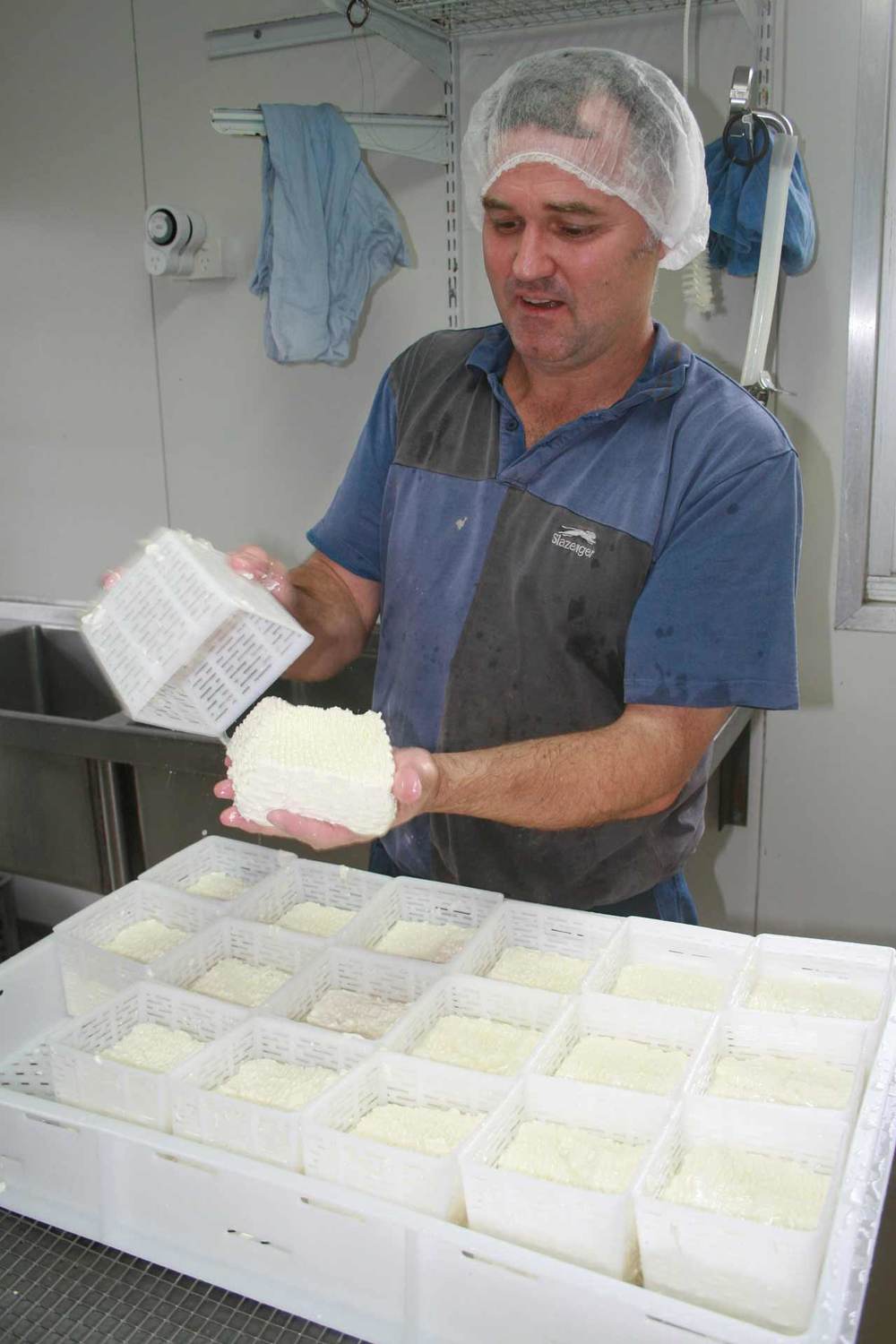
Brie and camembert
“To make brie and camembert, I use a Penicillium candidum bacteria which forms a white mould.”
Paul explains that most cheeses need to have acidifying starter cultures added to them in order to convert the milk sugars (lactose) into lactic acid.
He chooses each starter culture carefully in order to develop the cheese’s texture and flavour and says he is constantly learning and experimenting with different cultures.
“This one is a cows’ milk cheddar that I experimented with,” Paul says as he shows me a round yellowish cheese covered with lots of white and blue mould.
“People say it’s their favourite, but I haven’t been able to replicate it again.”
He picks up one of the large round cheeses and takes it through to another workroom where his staff are wrapping in plastic small rectangles of cheese which are ready for sale.
On the shelves nearby are plastic containers labelled Orange Billy, Chilly Billy and Lillian Fetta, all destined to be filled with fetta cheese mixed with oil, herbs and spices.
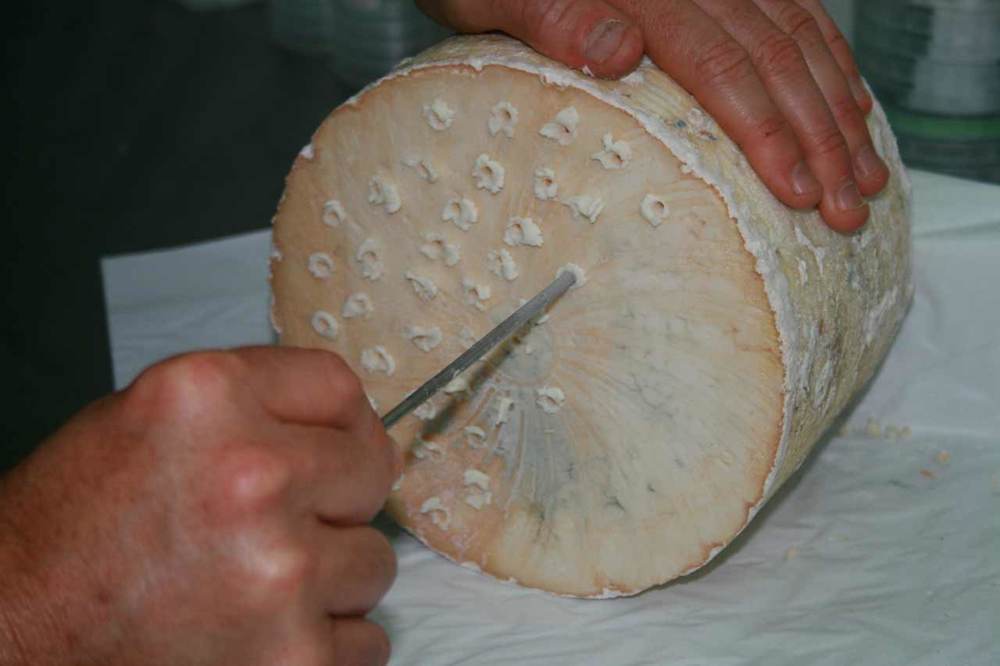
Mould
Paul passes the mouldy cheese to one of workers, who begins to push holes into it with a long skewer.
“This cheese was made with the blue cheese starter culture Penicillium roqueforti,” Paul explains.
“When we put it back into the fridge, over the next few weeks the holes will allow the air to penetrate to the inside and cause the blue mould to grow throughout the cheese.
“I have a French cheese maker coming to visit me later this week to help me work on my technique for making blue cheese and speed up the process.”
Paul checks the clock and it’s time to check on the vat of curds and whey in the other room again.
He shows me how he expertly fills lots of little plastic basket moulds with the soft thick curd.
“These will take a while to firm up,” Paul says as he turns the cheeses in their basket moulds, the excess whey dripping from them.
“I’ll turn them three of four times a day then sit them out for the night. Tomorrow, I’ll cut them in half and put them in brine to give them a salty flavour, then they’ll sit out another night to dry off.”
After that, it’s off to the fridge with these delicious morsels where they will grow their unique moulds on the outside and be ready for eating in about six weeks.
As I take off my cap and rubber slippers and leave the land of cheese behind, Paul is just getting ready to make one of my favourite cheeses: haloumi.
Now I know that haloumi gets its salty, rubbery texture from being cooked in whey and brine after being pasteurised.

Where does the cheese go?
Paul’s finished cheeses are sold online to be delivered in the Northern Rivers and the Gold Coast. He also sells them at the local farmers’ markets.
Due to Covid-19, Paul said the farm lost its wholesale food service business – which made up about 40% of sales.
“So, we’ve been trying to fill that gap in online sales and have started supplying Harris Farms,” Paul explained.
“We’ve also been working with Cheese Therapy online.
Innovation in Covid
“When we lost the sales, we still and had milk coming in, so we started making cheddar.
“It’s traditionally a way of preserving milk into a hard cheese. Traditional cheddar was crumbly and wrapped in a cloth and rubbed with pig fat to hold it together and keep its shape.
“So, we used cloth, but rubbed it in macadamia oil instead.
“It’s still maturing – it usually takes a minimum of three months. It’s just coming up to time to sell it, so we’ll sample some and put it out there.”
If you’re at the market and see Paul or Kerry, drop by and say ‘cheese’.
You can find out more about the cheese makers of Nimbin on their website at http://www.nimbinvalley.com.au
CAFE'S & RESTAURANTS


